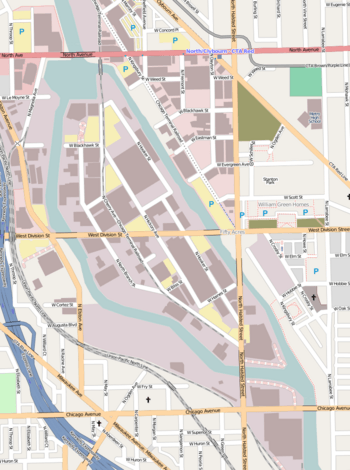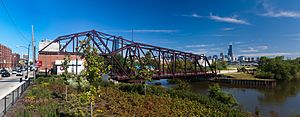Goose Island (Chicago) facts for kids

Street map of Goose Island
|
|
| Geography | |
|---|---|
| Location | Chicago River |
| Coordinates | 41°54′16″N 87°39′15″W / 41.90444°N 87.65417°W |
| Area | 160 acres (65 ha) |
| Length | 1.5 mi (2.4 km) |
| Width | 0.5 mi (0.8 km) |
| Administration | |
|
United States
|
|
| State | Illinois |
| City | Chicago |
Goose Island is a unique, man-made island in Chicago, Illinois. It's about 160 acres big, which is like 120 football fields! The island was created by the Chicago River on one side and a special canal called the North Branch Canal on the other. It stretches about 1.5 miles long and is about half a mile wide at its widest part.
Contents
How Goose Island Was Made
Goose Island wasn't always an island! Long ago, there was a small natural island nearby where many birds, especially geese, would gather. This might be how the name "Goose Island" came about.
In the 1840s, a group of Irish immigrants settled in the area. They called their settlement "Kilgubbin." Later, they moved a bit north to where the present-day Goose Island is located.
The land that became Goose Island was originally a big bend in the Chicago River. In 1853, William B. Ogden, who was Chicago's very first mayor, had a clever idea. His company bought land on the east side of the river. They started digging a channel to get clay for making bricks.
This digging created a shortcut across the bend in the river. By 1857, the new channel connected back to the river, officially forming the island! This channel became known as the North Branch Canal. It was made 50 feet wide and 10 feet deep so boats could easily travel through it. Some people even called the new island "Ogden's Island" after the mayor.
Early Settlers on the Island
After the island was formed, more people moved there. Besides the Irish settlers, many Polish and German immigrants made Goose Island their home. Life on the island was a mix of country and city living. Many families raised farm animals like chickens and pigs. They also worked in factories nearby. Over 100 homes were built, and shops and taverns opened up, creating a lively community.
Goose Island's Industrial Past
In the late 1800s, Goose Island became a busy industrial area. Large companies, like Peoples Gas, Light & Coke Co., built factories there. These plants produced a lot of smoke, earning the area the nickname "Little Hell."
By 1887, the island was home to:
- Two large buildings for storing grain (called grain elevators)
- Eleven coal yards
- A railroad line
This shows how important Goose Island was for Chicago's growing industries. However, by the early 1900s, many residents and some businesses started to move away from the island.
Getting to Goose Island
Goose Island is connected to the rest of Chicago by several bridges. Two main streets, Division Street and Halsted Street, cross the island.
- Halsted Street Bridges: The first bridge connecting Halsted Street to the island was built in 1866. Another bridge across the canal was added in 1874. The bridges you see there today were built in 1955 and 2012.
- Division Street Bridges: Division Street got its first bridge to the island in 1869. A second bridge across the canal followed in 1870. These were later replaced with special bridges called Bascule bridges in the early 1900s. One of these, the East Division Street bridge, was a very early example of a unique Chicago-style Bascule bridge. It was replaced with a temporary bridge in 2014.
Railroad Access
The Cherry Avenue Bridge at the northern tip of the island allows trains to reach Goose Island. Railroad tracks were first laid on the island in the 1870s. Today, the Chicago Terminal Railroad operates the trains that still use these tracks.
Bridges That Are No Longer There
Over the years, some bridges to Goose Island have been removed:
- Weed Street Bridge: In 1891, an experimental wooden bridge was built at Weed Street. It was a "jackknife" bridge that could fold up. However, it was hard to keep working and was removed in 1905.
- Blackhawk Street Bridge: For a short time around 1902, an old bridge from Division Street was moved to Blackhawk Street to provide access during construction. This bridge was also removed by 1910.
- Ogden Avenue Viaduct: A large elevated road, or viaduct, for Ogden Avenue crossed over the island starting in 1934. You couldn't get onto the island from this viaduct. It was torn down in 1992.
Goose Island Today: A Hub for Innovation
Goose Island has changed a lot from its industrial past. Like other parts of Chicago, old factories and warehouses are being turned into modern offices and creative spaces. People are calling this new era "Goose Island 2.0," "Silicon Island," or "Innovation Island."
Many exciting new businesses and facilities are now on the island:
- The Wrigley Corporation has a research and development center at the north end. This is where they invent new chewing gum and candy!
- The former headquarters of Sara Lee Corporation at the south end is now Kendall College, a school for culinary arts and hospitality.
- Amazon, Inc. has a special warehouse on the island. This warehouse helps them deliver packages super fast, sometimes in just one or two hours, to people in Chicago. It's Amazon's only distribution center right inside the city!
Goose Island is also home to MxD, which stands for the Digital Manufacturing Institute and National Center for Cybersecurity in Manufacturing. This institute has a huge research floor where they help American manufacturers use digital tools and new technology to make things better and safer.


